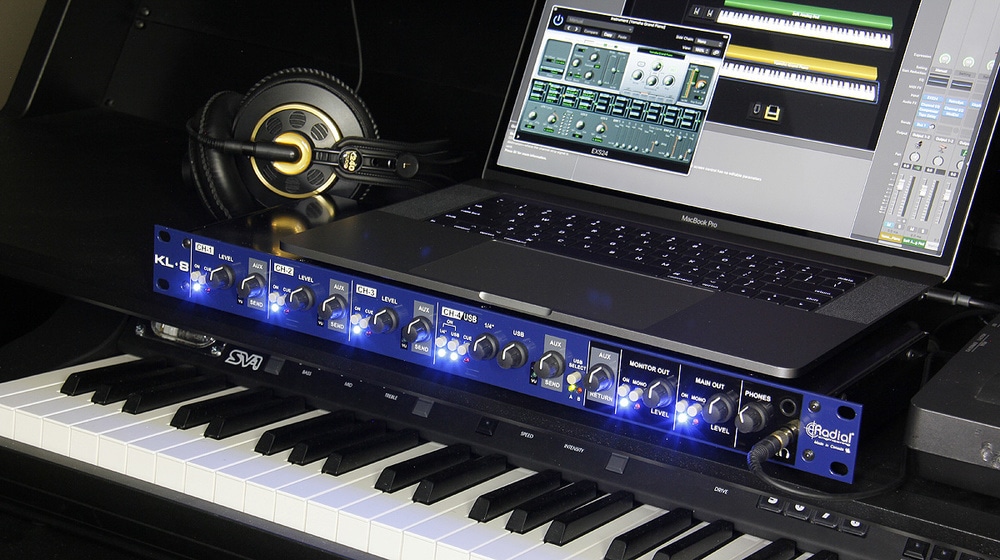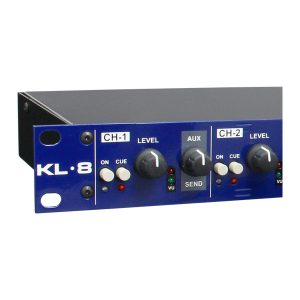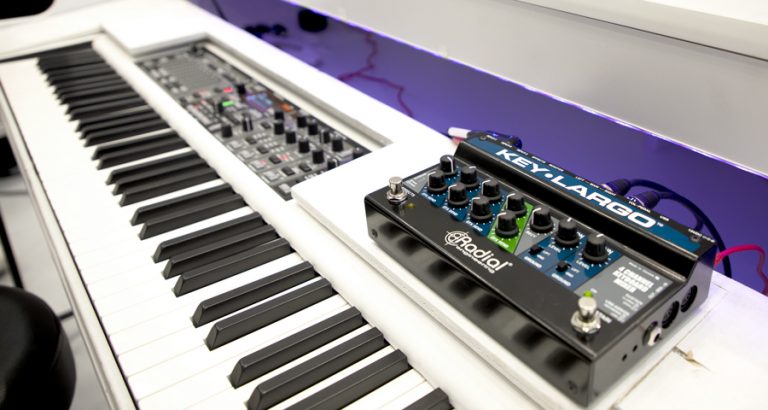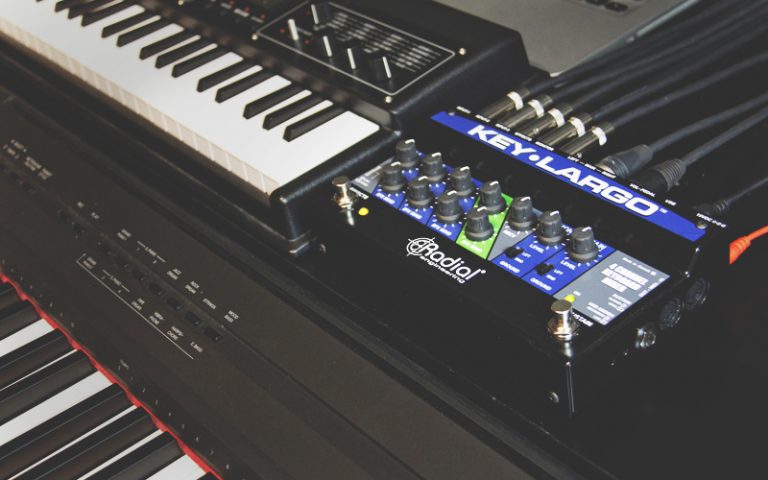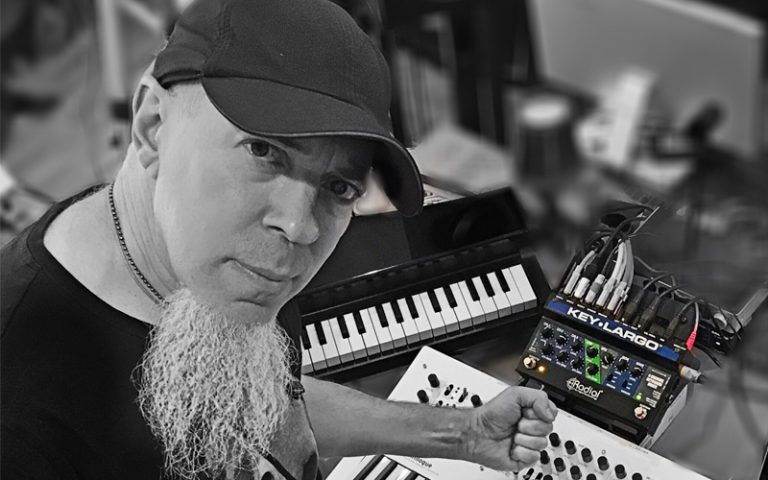This review originally appeared in the June 2019 edition of SoundonSound Magazine.
Review: Radial KL-8
Radial’s newest problem-solver could prove indispensible to gigging keyboardists.
By Hugh Robjohns
Back in January 2018, Bob Thomas reviewed — with high praise — a clever little keyboard mixer/interface pedal from Radial Engineering called the Key Largo. As a keyboard player myself I rather liked the concept, but the floor-pedal format didn’t appeal so I was overjoyed when Radial announced an enhanced rackmount version at the 2018 NAMM show. We’ve had to wait a full year for the product to become a reality, but I’m delighted to report that sat in front of me now is the new KL‑8.
Built into a 1U-high, black-painted chassis with a striking blue front panel, the new KL‑8 extends almost 160mm (6.25 inches) behind the rack ears and weighs a substantial 3kg (6.6lbs), largely due to Radial’s traditional heavy-duty steel chassis construction. The product name references both the original Key Largo and the fact that this unit has eight instrument inputs (four stereo pairs) instead of its sister model’s six.
There are a few other differences too, which start with its universal (100-240V AC) switch-mode line-lump power supply. Although this is still external, it is more sophisticated than the Key Largo’s. It delivers a trio of ±15V and +5V power rails (the Key Largo uses a single +15V supply), and connects using a reassuringly secure, latching four-pin XLR. There is no power switch, so if it’s plugged in, it’s on.
Importantly, the mains safety earth is carried through to the rack chassis and all of the instrument inputs are referenced to it directly, so any Class-2 (double-insulated) instruments can be assured of a solid ground reference via the KL‑8. Sensibly, ground-lift buttons are provided on both the main and monitor outputs to help solve ground-loop problems with destination equipment, should they arise.
The back panel is awash with closely packed connectors, starting with eight unbalanced quarter-inch TS sockets for the stereo keyboard inputs; plugging a mono instrument into a left-channel socket provides a dual-mono signal into the stereo mix bus. Four more TS sockets provide a stereo auxiliary effects loop with separate left/right sends and returns, and again there’s some clever cross-linking between the sockets so that a mono effects pedal can be plugged into the left send and return to receive a mono‑summed aux output and deliver a dual-mono return. A pair of TRS sockets provides a stereo mix-bus insert send/return (normalled to maintain the signal path when nothing is plugged in), and is intended for use with a stereo volume pedal or an overall effects processor.
Both the main and monitoring outputs are presented on male XLRs, each pair with an independent ground-lift button as mentioned above. Slotted in between these are two further TRS sockets which provide direct mix-bus access so that multiple KL‑8s can be linked together for larger rigs, and two more TS sockets on the left-hand side accept remote footswitch connections to toggle between the two USB inputs (see below) and to mute the auxiliary send/return signal path.

Finally, there’s the XLR4 power inlet, a couple of Type-B USB 2.0 sockets, a Live/Rec mode button (more on that later), and two five-pin DIN MIDI sockets for passing data in and out of the computer over USB (nothing in the KL‑8 can be MIDI controlled, so these sockets are redundant if a computer is not connected). Although only one of the USB sockets can be active at a time, this dual-socket arrangement allows main and reserve computers to be connected simultaneously and selected at the press of a button (or footswitch) with a virtually instantaneous change-over — another reassuring facility for professional live-performance applications. All standard sample rates to 192kHz are supported.
The Live/Rec mode button reconfigures the unit’s signal, with the default Live mode bringing the USB replay signal in as a standard replay source alongside the instrument inputs. The stereo mix bus (post the stereo insert point) is also routed out to the computer so that the entire performance (including any virtual instruments) can be recorded.
In contrast, switching to the Rec mode brings the USB replay signal back into the main and monitor output section (post insert point), bypassing the mix bus completely. In this way a stereo mix of analogue instruments (plus the aux return signal) is sent to the computer for recording, while replays from the computer appear only on the main and monitoring outputs. This configuration thus makes it possible to play along to a backing track while recording clean keyboard parts, which is handy.
Hands-on Controls
Moving around to the front panel, the suite of controls completely fills the available panel space, but the layout is clear and logical, with crisp white legends easily visible on the blue background. Status LEDs accompany every button, too, with dazzlingly bright blue Channel On lights.
The first three instrument channels are equipped with a rotary input attenuator, an On button to route the signal to the main output, a Cue button (which takes the signal off the main mix bus and sends it instead to the headphones), and a pair of red/green LEDs to indicate signal levels (green above -18dBu and red at +18dBu). A second rotary control for each channel sets the aux send level, which is derived from the mix bus contribution (so disappears if the Cue button is pressed).
Unity gain from input to output is achieved with the channel input and main output controls both at the 2 o’clock position. There is +10dB of additional gain available above that for the input control, and +8dB for the output control, so sources can be boosted by up to 18dB, if required.
Radial state that the maximum instrument input level is +18dBu, but I found the KL‑8 was still singing fairly nicely at a massive +20dBu — not that any normal keyboard is likely to be putting out that kind of signal! Conversely, the minimum input level required to achieve a nominal +4dBu line level at the balanced outputs is -14dBu (achieved with both the input and output controls at maximum). Obviously, lower source levels result in a lower output level, but the noise floor is sufficiently low to accommodate quieter instruments without significant problems.
Instrument input four also has its own input attenuator, but alongside is a rotary level control for adjusting the signal from the internal USB interface. Both sources have independent On buttons to route them into the main mix and both can be used simultaneously, but they share a Cue button, dual-LED meter and aux Send control. Also in this section is a button (with status LEDs) to toggle between the USB inputs.
Outputs
The KL‑8’s output section is delineated by a black background, and starts with a rotary knob for the aux return level (which can be used as a fifth stereo instrument input, if required). Two more knobs adjust the main and monitor output levels, each with buttons to turn their respective outputs on and to sum the stereo signal to mono. Unusually, there is no output level metering, and nothing to indicate whether the unit is configured in its Live or Rec modes either — not even a status LED by the rear-panel button, which could easily get knocked while plugging USB leads in.
Turning the main output control down to the nine o’clock positon introduces about 30dB of attenuation, reducing the nominal line output down to that of a strong microphone signal, should that be required when plugging into a stage snake. The transformer‑isolated outputs are tolerant of, and protected against, phantom power on the connecting lines, of course.
A headphone volume control completes the front panel, driving an adjacent pair of standard, paralleled, quarter-inch TRS sockets. These powerful outputs normally carry the monitor mix, but this is replaced with direct input channels when the Cue buttons are pressed (a red LED shows when the Cue system is active).
“The KL‑8 is an impressive keyboard mixer with a well-focused feature set, superb flexibility and configurability, great technical performance, and solid reliability.”
Finally, one additional configuration slide-switch is recessed into the KL‑8’s top panel. While this is not a very convenient location on a rackmounting device it’s an option that will rarely need to be changed, and there simply isn’t any front- or rear-panel space available elsewhere anyway! This switch determines the signal routing for the auxiliary return, with the factory setting (labelled ‘All Outputs’) bringing it directly into the main mix bus to be heard in the main, monitoring and headphone outputs. Flipping the switch removes the aux returns from the main mix completely, so that they are only audible through the monitoring and headphone outputs (‘Monitor & Headphones Only’). This latter condition is intended for performers who need to monitor a click track, say, without passing it on to the mix outputs. So the click-track signal would be connected to the aux return and adjusted with the aux return volume knob. The normal instrument input channels can still contribute to the aux send, of course, but any send/return effects would need to be brought back into the mix via one of the other instrument channels.
In Use
As the USB interfacing is class compliant, no drivers are required when connecting to a Mac, but a driver is required for Windows platforms (free on the Radial web site: Xmos 3060 v4.11 at the time of writing). Unfortunately, when connected to either a powerful Windows 7 desktop machine or an MS Surface 4 (i7 and Windows 10), I found this Xmos driver demanded a buffer size of 1700+ samples with an 18ms latency, and it produced regular clicks and splats. However, the Radial web site recommends installing asio4all after the Xmos driver and, using that instead, I was able to obtain reliable working with a buffer size of 128 samples.
Playing virtual instruments and backing tracks from the computer worked fine in both the Live and Rec modes, and the KL‑8’s gain structure is set up so that full-scale digital audio from the computer can’t overload the stereo mix bus even with the USB level control flat out. This is obviously very sensible and guarantees that soft synths or backing tracks can’t cause any accidental clipping within the KL‑8. In fact, with the USB control maximised, a 0dBFS replay signal reaches the stereo mix bus at +10dBu, and delivers +18dBu at the main outputs if the output control is maxed too.
However, a side-effect of this gain structure is that a USB-recorded performance replays noticeably quieter than the source. For example, with a keyboard input set to give 0dBu at the mix bus, the digital signal reaching the DAW is -18dBFS, which leaves a generous headroom margin. But playing that recorded signal back produces an output which is 8dB quieter than the live keyboard, even with the USB level control at maximum (and it’s the same in both the Live and Rec configurations). I raised this disparity with Radial, who acknowledged my observation but said: “The ability to use the KL‑8 as a recording interface is more of an additional feature than a primary application.”
I take the point. The KL‑8 is, first and foremost, a live-performance keyboard mixer with integrated USB replay facility, and it sounds great and works extremely well in that context, and many will be willing to overlook the level discrepancy and consider the ability to also record over USB a useful extra, rather than thinking of the KL‑8 as a dedicated recording interface. Personally, though, I find it disappointing as it limits the KL‑8’s convenience in a studio situation. However, for studio working it would have been far more attractive if the unit incorporated a multi-channel USB output so that each keyboard part could be captured individually on its own (stereo) track in the computer. So I also raised this thought with Radial who responded that they, “didn’t want to directly compete with the saturated market that exists for multichannel studio recording interfaces”. Again, I can’t argue with that stance, although I can’t help thinking that a multi-channel recording capability with a consistent record-replay gain structure would have elevated the KL‑8 into a genuinely great live/studio all-rounder keyboard interface — one which would be unique in the current market meeting the demands of session keyboardists everywhere!
Nevertheless, the KL‑8 is an impressive keyboard mixer with a well-focused feature set, superb flexibility and configurability, great technical performance and solid reliability. Its rackmount format and slightly altered features set complements the Key Largo, and will appeal to a different subset of customers. I enjoyed using it a great deal, and found it a genuine asset in my own live keyboard rig.
Tech Specs
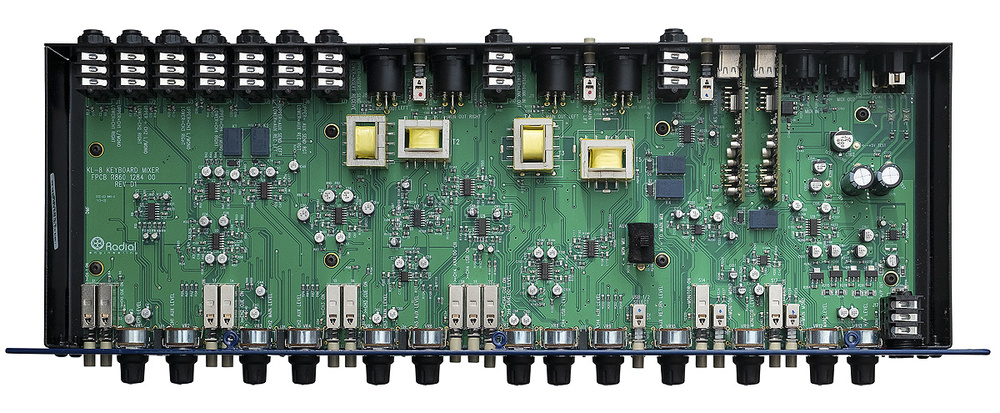
The KL‑8s internal construction is to a very high standard, and should prove rugged and reliable over a long lifespan. A single PCB, carrying mainly surface-mount components, occupies the full floor area of the chassis, with all the controls and connectors attached directly to the board. Two small, vertical daughter cards carry the USB interfaces (the same well-proven design employed in the Key Largo). Each sub-board features an XMOS USB-handling chip and a Cirrus Logic CS4270 stereo A-D/D-A converter, which supports 24-bit audio at all standard sample rates up to 192kHz with a quoted dynamic range of 105dB.
Presumably as a result of the revised powering arrangements, the KL‑8 has more headroom than its sibling, with the balanced main and monitor outputs clipping at +28dBu (4dB higher), while also accommodating 6dB more instrument input level (clipping at +18dBu). The unbalanced aux send output can manage +18dBu, which is fine but — unexpectedly — the aux return input clips at +11dBu. The signal-to-noise ratio measures -90dB (ref +4dBu), and THD measures 0.002 percent (same reference level) with predominantly third-order harmonics (although the harmonic balance levelled out with more conventional instrument input levels (-20dBu). A high‑resolution FFT analysis of the quiescent noise-floor showed it to be completely free of any mains-related hum components and averaged around -120dBu, which is impressive.
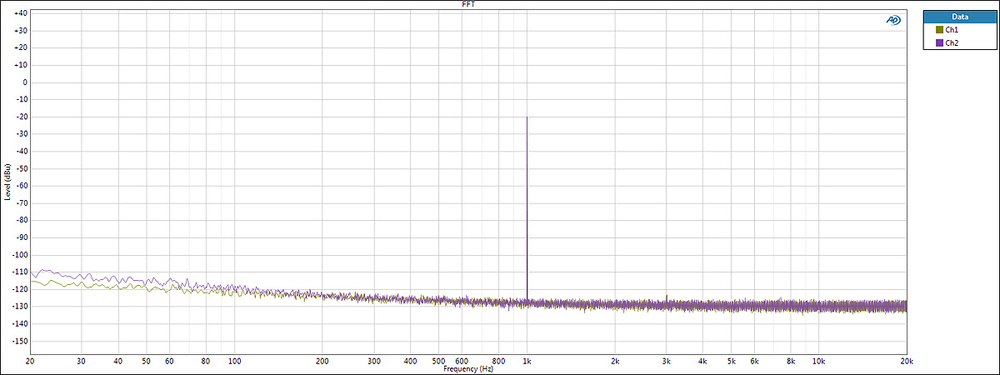

The analogue audio signal paths are processed through low-noise Texas Instruments OPA1664 quad op-amps (although I also spotted an LM3234 quad op-amp in the sux send/return circuitry), and sealed relays take care of signal path reconfigurations and aux send/return muting. Crosstalk between left and right input channels measured a respectable -59dB at 10kHz and a healthy -85dB at 1kHz, while the channel ‘off-ness’ measured -78dB with the On button released, and -72dB when the level knob was at minimum.
Frequency response measured flat (±0.5dB) between 20Hz and 20kHz when the output was connected to typical destinations with impedances between 10-50 kΩ. However, both the high-end response and overall output level are affected by unusually high- or low-impedance destinations. Anything above 100kΩ emphasises a 50kHz resonance peak in the output transformers, while connecting a destination impedance of 600Ω causes the overall output level to drop by around 9dB and roll off above 18kHz. Thankfully, neither condition is likely to occur in normal KL‑8 applications.
Running my usual AES17 dynamic range test on a round-trip through both A-D and D-A stage via the USB interface, I obtained 105dB (A-weighted), matching the converter chip’s theoretical performance and indicating a very good circuit implementation. Obviously this dynamic range figure falls short of current high-end converter performance (which is pushing past 120dB these days), but I’d argue it is entirely acceptable for the intended application.
The headphone amp can deliver 0.4 Watts per channel into 15Ω (8.3V RMS maximum voltage), and I found it capable of a generous volume when using a range of typical studio headphones and in-ear monitors.

